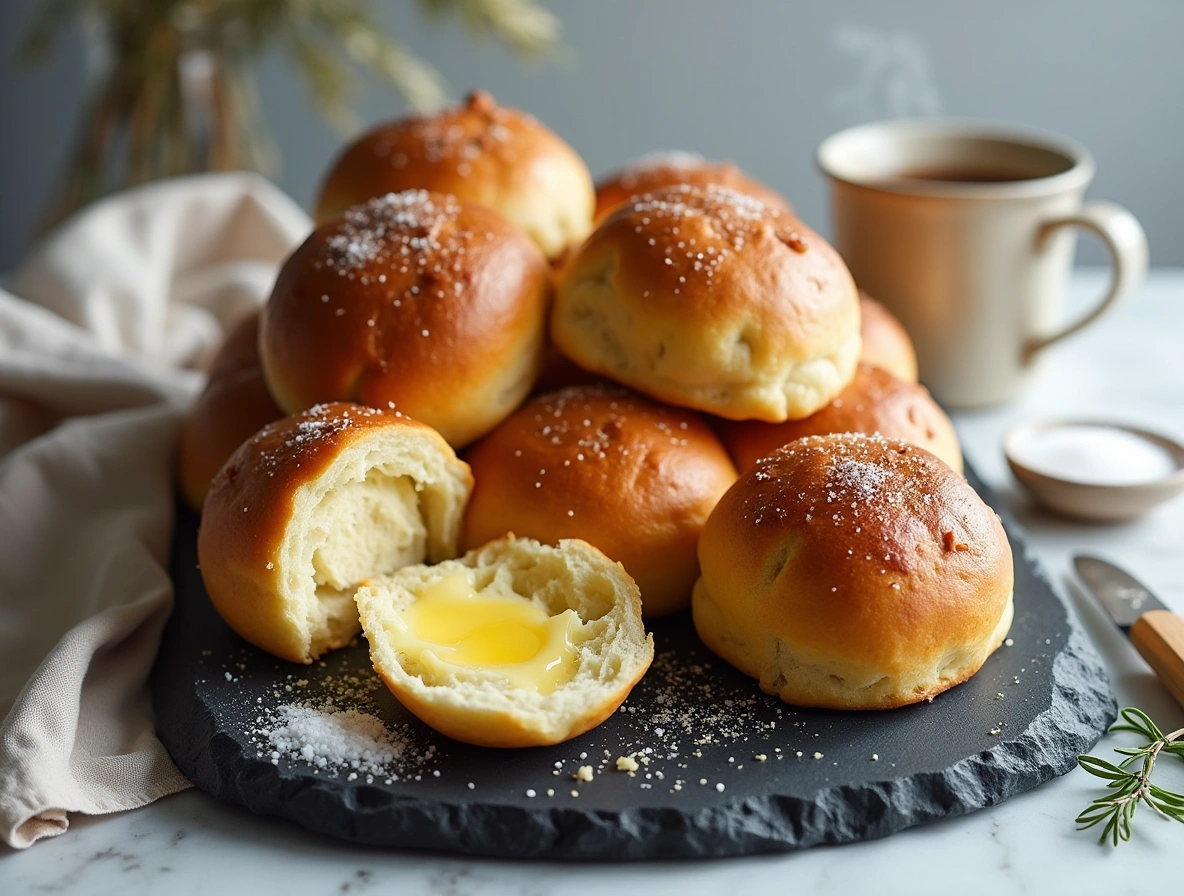The first time I made these brioche dinner rolls, my kids hovered around the oven like little bread monsters. When they finally came out golden, buttery, and smelling like heaven they disappeared in minutes. Now, these rolls are a must at every family dinner.
There’s something magical about brioche. It’s rich, tender, and just sweet enough to make you want one more bite. And the best part? They’re easier to make than you think. No fancy tricks just real ingredients, a little patience, and a whole lot of love.
Let’s bake the softest, dreamiest brioche rolls you’ve ever tasted.
Why These Brioche Dinner Rolls Will Steal the Show
If you’ve ever had store-bought brioche, forget it. Homemade is a game-changer. These rolls are:
✅ Cloud-soft – Thanks to the perfect mix of eggs and butter.
✅ Slightly sweet – Just enough to pair with savory dishes (or slather with jam).
✅ Make-ahead friendly – Proof overnight and bake fresh in the morning.
My grandma always said, “Good bread takes time but it’s worth every second.” She was right.

The 5 Ingredients You Can’t Skip
Brioche is all about quality ingredients. No shortcuts here!
- Real butter – No margarine. Grandma would never. Unsalted lets you control the salt.
- Fresh eggs – They give brioche its golden color and richness.
- Whole milk – Warm it just enough to wake up the yeast (about 105°F not hot!).
- Good yeast – If it doesn’t bubble when mixed with milk, it’s too old.
- A pinch of love – Okay, not an ingredient, but essential.
Step-by-Step: How to Make Perfect Brioche Rolls
1. Wake Up the Yeast (The Most Important Step!)
- Warm ¾ cup milk (think baby-bottle warm, not hot).
- Whisk in 1 ½ tsp yeast + 1 tbsp sugar. Let it sit 10 minutes it should get frothy like a tiny beer. No foam? Your yeast is sleepy (or dead). Start over.
2. Mix Everything (Except the Butter Patience!)
- In a stand mixer with the dough hook, add:
- 4 cups flour (spooned in, not packed!)
- ¼ cup sugar + 1 tsp salt
- 3 eggs
- The frothy yeast mix
- Mix on low until combined, then high for 4-5 minutes until it forms a shaggy dough.
3. Add the Butter Slowly!
- Cut ½ cup softened butter into chunks.
- Add a few pieces at a time while mixing on high.
- Keep going 5-10 minutes until the dough is smooth, shiny, and no longer sticks to the bowl.

Anna’s Tip: If your kitchen is warm, pop the dough in the fridge for 10 minutes if it gets too sticky.
4. Let It Rise (Twice for Extra Fluff!)
- First rise: Put dough in a greased bowl, cover, and let it double (1 hour).
- Shape rolls: Punch down, divide into 12 balls, and place in a 9×13″ baking dish.
- Second rise: Cover and let them puff up again (1 more hour).
Shortcut: Refrigerate overnight after shaping! Just let them sit at room temp 20 minutes before baking.
Don’t forget this delicious recipe: Cheesesteak Tortellini in Rich Provolone Sauce: The Ultimate Comfort Food Recipe
5. Bake to Golden Perfection
- Brush with egg wash (1 egg + 1 tsp water).
- Bake at 350°F for 25 minutes they should sound hollow when tapped.
FAQs
Why does brioche dough take so long to mix?
Brioche is packed with butter and that’s what makes it so deliciously rich! Mixing slowly allows the dough to fully absorb all that butter, creating a soft, tender crumb. A stand mixer does the heavy lifting, but if you knead by hand, expect an arm workout!

What’s the best way to eat brioche?
- Slathered with butter (the more, the better).
- Toasted with jam or Nutella (just like my brioche donuts!).
- As sandwich buns (pulled pork, chicken, or even a fancy burger).
Should brioche be served warm?
Either way! Warm = melty butter heaven. Room temp = still soft and delicious.
Can I make them in advance?
Yes! Shape the rolls, cover, and refrigerate overnight. Let them sit at room temp for 20 minutes before baking.
What’s the difference between brioche and milk buns?
- Brioche = rich, buttery, slightly sweet (thanks to eggs + butter).
- Milk buns = softer, lighter, less rich (more milk, less butter).
What is milk brioche?
A hybrid! It’s brioche dough with extra milk for a softer, slightly less dense texture.
How do you eat milk brioche rolls?
Just like classic brioche with butter, jam, or as sandwich buns!
Bun vs. brioche bun what’s the difference?
- Regular bun = basic bread (flour, water, yeast).
- Brioche bun = enriched with eggs + butter (softer, richer).
Is brioche healthier than bread?
Not really it’s a treat! The butter and eggs make it higher in calories, but oh-so-worth-it.
Does Chick-fil-A use brioche buns?
Yes! Their buns are buttery and soft, similar to brioche.

How do the French eat brioche?
- For breakfast with coffee.
- As pain perdu (French toast).
- Plain, because it’s that good.
What do milk rolls taste like?
Soft, slightly sweet, and ultra-pillowy like a lighter version of brioche.
Does Walmart sell brioche bread?
Yes! Look for brands like Pepperidge Farm or store-brand brioche.
Why is milk bread so good?
The extra milk (or sometimes tangzhong, a cooked flour paste) makes it incredibly soft and fluffy.
Why is brioche more expensive?
Real brioche uses lots of butter + eggs, unlike cheaper breads that swap in oils.
Why does brioche taste so good?
Butter. Eggs. Sugar. Love. Need I say more?nts. Cheaper versions often use shortcuts (hello, extra oil instead of butter).
My dear friend, as we come to the end of this brioche journey together, I want to share something personal with you. The first time I made these rolls exactly as my grandmother taught me, I cried when I pulled them from the oven. Not because they were perfect (though they were pretty darn close), but because in that moment, I realized I wasn’t just baking bread – I was keeping alive a tradition that stretched back generations in my family.
Why These Brioche Rolls Are More Than Just Bread
Let me tell you what makes these rolls truly special:
- They’re edible memories – The way the butter smells as they bake instantly transports me to my nonna’s kitchen, where she’d let me shape the dough into little animals (my bunnies always looked more like blobs, but she praised them like Michelangelo’s sculptures).
- They’re your secret superpower – Nothing impresses guests like pulling homemade brioche from your oven. Suddenly you’re not just a cook – you’re a kitchen wizard.
- They teach patience – In our fast-food world, these rolls remind us that the best things in life (like love and good bread) can’t be rushed.
My Grandmother’s Final Lesson (The One It Took Me Years to Understand)

After a lifetime of baking, my nonna whispered her true secret to me: “Anna, the dough knows when you’re stressed. Bake with joy or don’t bake at all.” At the time I thought she was being poetic, but now I know – the days I bake frustrated are the days my rolls come out dense. The days I bake while singing to my kids? Pure magic.
This is why I beg you: Don’t make these rolls when you’re in a hurry. Make them on a lazy Sunday when you can:
- Enjoy the rhythmic kneading
- Savor the sweet, yeasty smell as they rise
- Watch in wonder as they turn golden
- Experience that first heavenly bite
All the Little Tricks I’ve Learned Over the Years (That You Won’t Find in Cookbooks)
- The Windowpane Test That Never Fails
Stretch a small piece of dough between your fingers – if you can see light through it without tearing (like a bakery window), you’ve kneaded enough. If not, keep going! - The Butter Temperature Sweet Spot
Your butter should be soft enough to leave a fingerprint when pressed, but not oily. I leave mine out overnight in winter, just 2 hours in summer. - The Rise That Tells All
Your first rise is done when you gently poke the dough and the indentation stays. If it springs back, give it more time. If it collapses, you’ve overproofed (but don’t worry – they’ll still taste amazing). - The Egg Wash Secret
For that perfect glossy top, strain your egg wash through a fine sieve first. And apply it with a feather-light touch – no globs!
When Things Go Wrong (And How to Fix Them Like a Nonna Would)
Problem: My rolls are dense!
Solution: Your yeast might be old. Next time, proof it first. For now? Call them “artisan-style” and serve them with extra butter.
Problem: The tops are too dark!
Solution: Tent with foil after 15 minutes. Next time, bake on a lower rack.
Problem: They’re dry the next day!
Solution: Brush with simple syrup while warm next time. For now? Make bread pudding!
Remember: There are no baking failures – just new recipes waiting to be discovered.

The Ripple Effect of Homemade Bread
What surprised me most wasn’t how much my family loved these rolls, but how they changed our home:
- My teenager now asks to help knead when he’s stressed
- My daughter sets the table without being asked on brioche nights
- My husband (who “doesn’t cook”) has mastered shaping the rolls
This is the true magic – these rolls don’t just feed stomachs; they feed connections.
Your Invitation to Continue the Tradition
Now it’s your turn, my friend. I want you to:
- Make these rolls exactly once by the recipe
- Then make them again with your own twist (maybe orange zest? A sprinkle of sea salt?)
- Teach someone you love how to make them
- Share your story with me
Because here’s the beautiful truth – every time you bake these, you’re not just making bread. You’re:
- Preserving centuries of baking wisdom
- Creating edible love letters for your family
- Adding your own chapter to the great story of home cooking
One Last Thing Before You Go…
However your first batch turns out – whether they’re bakery-perfect or hilariously lopsided – please know this: You’ve already succeeded. Because you cared enough to try. You invested time and love into nourishing those around you. And that, my dear friend, is what makes a true cook.
Now go preheat that oven, tie on your apron, and let’s fill the world with the smell of freshly baked love. I can’t wait to hear about your brioche adventures!
With all my heart and a flour-dusted nose,
Anna
P.S. When you make these, take a photo of your hands covered in dough. Years from now, you’ll treasure that memory even more than the recipe itself. 💛


